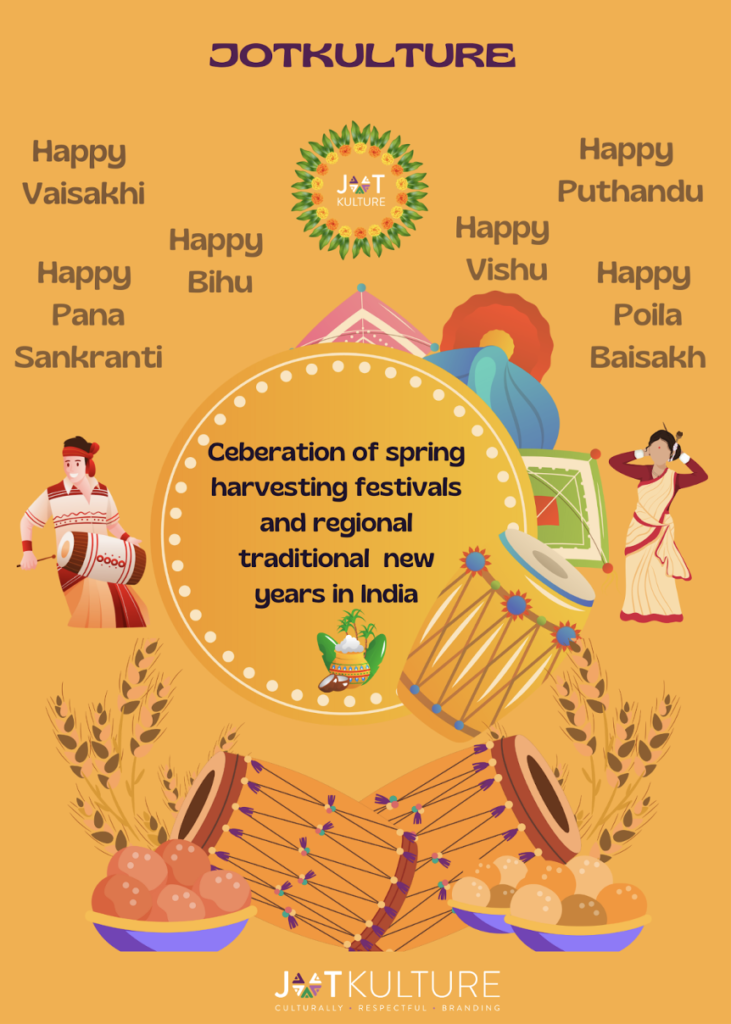Spring harvesting festival of India : One nation – Diverse celebrations
Last week, people from various parts of India celebrated various local festivals. In April the new crop harvests and traditional regional new year begins. At this time, they engage in a variety of celebrations to commemorate that joyous occasion. Many harvest festivals and regional new year celebrations are observed throughout India. These events have different names in different regions: Bihu in Assam, Baisakhi in Punjab, Poila boisakh in Bengal, Panna Sankranti or Maha Vishuva Sankranti in Odisha, Vishu in Kerala, and Puthandu in Tamil Nadu.
India being an agriculture-heavy economy, farmers and harvests are significant parts of our culture. A significant segment of the Indian populace is actively involved in agricultural pursuits. Consequently, the first harvest of their new crop is a very happy moment for them. It is a moment to celebrate the food that has been cultivated. For this reason, people celebrate the spring harvest season with great enthusiasm . During this time, people rejoice at the harvest and offer prayers for the soil’s fertility during this time.
Vaisakhi: Celebrated predominantly in the northern states of Punjab and Haryana, Baisakhi or Vaisakhi marks the Sikh New Year and the harvesting of the Rabi crops. It is also significant as the day of the formation of the Khalsa Panth by Guru Gobind Singh in 1699. The festival is celebrated with fervor, including processions, traditional folk dances like Bhangra and Gidda, music, and the offering of prayers at gurdwaras.
Vishu: Vishu is celebrated in the southern state of Kerala, particularly by the Malayali community, as the Malayali New Year. It usually falls on April 14th or 15th and marks the beginning of the Malayali calendar. Vishu is celebrated with rituals such as Vishukkani, where auspicious items are arranged and viewed first thing in the morning, and Vishukkaineetam, where elders give money or gifts to younger members of the family. Traditional delicacies are also prepared, and fireworks are often part of the celebrations.
Puthandu: Puthandu, also known as Tamil New Year, is celebrated by the Tamil community in the state of Tamil Nadu and Puducherry, as well as in Sri Lanka and other Tamil diaspora communities. It usually falls on April 14th and is celebrated with rituals such as Kolam (rangoli), visiting temples, and preparing a special dish called “Mango Pachadi” which symbolizes the different flavors of life. Traditional attire, music, and dance are also part of the celebrations.
Poila Boishakh: Poila Boishakh is celebrated on April 14th or 15th in and around West Bengal and Bangladesh marking the beginning of the Bengali New Year and the spring season. During Poila Boishakh, people engage in various rituals, cultural activities, and festivities to welcome the new year and celebrate the onset of spring. Cultural programs, music concerts, dance performances, and traditional folk performances are organized in various communities to celebrate Poila Boishakh. Durinng this time many people visit temples, offer prayers, and seek blessings from deities for a prosperous and auspicious year ahead.
Pana Sankranti: Pana Sankranti, also known as Maha Vishuva Sankranti is a traditional festival celebrated in the Indian state of Odisha which marks the beginning of the Odia New Year and typically falls on April 14th or 15th. During Pana Sankranti, people observe various rituals and traditions to welcome the new year and seek blessings for prosperity and happiness. One of the central elements of the festival is the consumption of a traditional drink called “Pana,” which is made from ingredients like water, sugar, milk, yogurt, and various fruits.
Bohag Bihu: Bohag Bihu, also known as Rongali Bihu, is the Assamese New Year festival celebrated in the northeastern state of Assam. It marks the beginning of the Assamese calendar and the onset of the Assamese spring festival. Bohag Bihu usually falls in mid-April and is celebrated with traditional music, dance (Bihu dance), feasting, and community gatherings. Traditional Assamese dishes such as pitha (rice cakes) and larus (sweet balls) are prepared during the festival.
Although the regional festivities vary, the essence of these festivals are the same everywhere. This is a joyous occasion that celebrates the renewal of life, the onset of a new agricultural cycle, the coming of spring and new solar year . It is a time for community gatherings, religious observances, and cultural festivities, symbolizing hope, abundance, and the spirit of renewal.
Sucharita Ghosh, JotKulture






